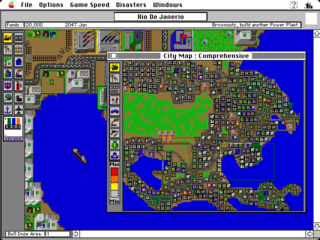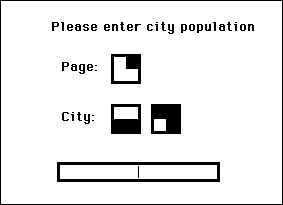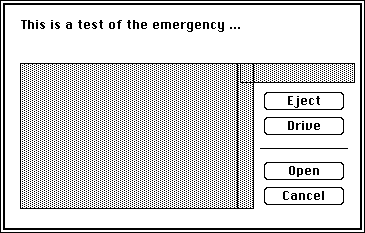SimCity (Mac OS Classic)
| SimCity |
|---|
|
Also known as: SimCity Supreme, SimCity Classic
|
The Macintosh SimCity was the first release in the Maxis Sim line. Its success proved to a skeptical industry that creative, open-ended gameplay was as legitimate a form as zero-sum competition.
Contents
Revisional Differences
The following versions are known to exist:
| B&W | Color |
|---|---|
| 1.0 | |
| 1.1 | 1.1c |
| 1.11 | |
| 1.2 | 1.2c |
| 1.3 | 1.3c |
| 1.4 | 1.4c |
| 1.5 |
Godzilla vs. Notzilla
In Version 1.2, legal action by Toho Co. forced the replacement of a certain unnamed kaiju by an orange salamander with a far less intimidating battle cry. (In Version 1.5, this monster has had a growth spurt and its voice has broken.)
| v1.1 | v1.2 | v1.5 |
|---|---|---|
 |
 |
 |
The first two sounds are internally named "God"; the third one is "Monster".
Self-Destruct
In v1.3 and later, type NUKE to simultaneously demolish every developed tile on the map.
Football Score
Use the Query tool (hold down Q and click) on the turf of a stadium during a football game to display the score... which is always the same, but depends on which version you're playing in. Up to v1.4, it's 49er's 38 Bears 3; in v1.5, it's New Orleans 35 - SF 6. (The San Francisco 49ers were Maxis' home team.)
Assorted Fixes
- Version 1.0 had an exploit where the mayor could raise taxes to the maximum 20% each December, collect the full amount in January, and leave them at a crowd-pleasing 0% the rest of the year. As of v1.1, tax is collected at the average rate set over the past year.
- Up to v1.2, the Edit window's close box was a nonfunctional dummy that lit up when clicked but didn't close the window. As of v1.3, it prompts you to save and takes you back to the main menu.
- In v1.5, "Rio de Janerio" was finally corrected to "Rio de Janeiro" in the title bar.
Copy Protection
Versions 1.0 and 1.1 required inserting the master disk at every launch.
Versions 1.11, 1.2, and 1.3 had the player enter one of hundreds of population figures, printed on four hard-to-photocopy red sheets, into the box at right. After three wrong answers, the game would begin but the area would immediately be racked by explosions and earthquakes that never let up.
Both of the above protection schemes only applied to the black and white editions; the color equivalents were unprotected.
Versions 1.4 and 1.4c required the program to be personalized with the owner's name. Whatever you entered would be added to the credits under "Licensed To".
Version 1.5 was not protected in any way.
Version 1.5
Version 1.5, retitled SimCity Classic on its new title screen, brought the most substantial changes:
- 256-color graphics.
- Revised sound effects.
- Optional background music.
- Native PowerPC code.
- A redesigned interface with horizontal toolbars and a portable Status window.
- A button for the Query tool.
- A more compact Map window, with roaming letters to indicate Trains, Ships, Airplanes, Helicopters, Monsters, and tornaDoes.
- Importing and exporting of PC-formatted .CTY files.
| v1.4 | v1.5 |
|---|---|

|

|
| To do: Compare all sounds. |
Unused Tiles
Even though v1.5 discontinues black and white support, its PICT resources include a monochrome graphics sheet that reveals some never-used early graphics:
Unused Menus
An unused Apple menu and debug menu are found only in v1.5. (Sprocket was an application framework published by MacTech magazine.)
Unused Dialogs
In v1.3 and v1.4, DLOG 4000 is a placeholder file-opening interface. The text isn't cut off; "emergency ..." is what was actually written.
In v1.5, DLOG 1299 (titled "stubbie") is this cryptic dialog.
Creator Code
The program's four-letter identifier, MCRP, is a remnant of the game's working title "Micropolis".
- Pages missing developer references
- Games developed by Maxis
- Pages missing publisher references
- Games published by Maxis
- Games published by Infogrames
- Games published by Imagineer
- Mac OS Classic games
- Pages missing date references
- Games released in 1989
- Games released in February
- Games released on February 2
- Games with hidden development-related text
- Games with unused graphics
- Games with debugging functions
- Games with revisional differences
- To do
- Sim series
Cleanup > Pages missing date references
Cleanup > Pages missing developer references
Cleanup > Pages missing publisher references
Cleanup > To do
Games > Games by content > Games with debugging functions
Games > Games by content > Games with hidden development-related text
Games > Games by content > Games with revisional differences
Games > Games by content > Games with unused graphics
Games > Games by developer > Games developed by Electronic Arts > Games developed by Maxis
Games > Games by platform > Mac OS Classic games
Games > Games by publisher > Games published by Atari, SA > Games published by Infogrames
Games > Games by publisher > Games published by Electronic Arts > Games published by Maxis
Games > Games by publisher > Games published by Imagineer
Games > Games by release date > Games released in 1989
Games > Games by release date > Games released in February
Games > Games by release date > Games released in February > Games released on February 2
Games > Games by series > Sim series












